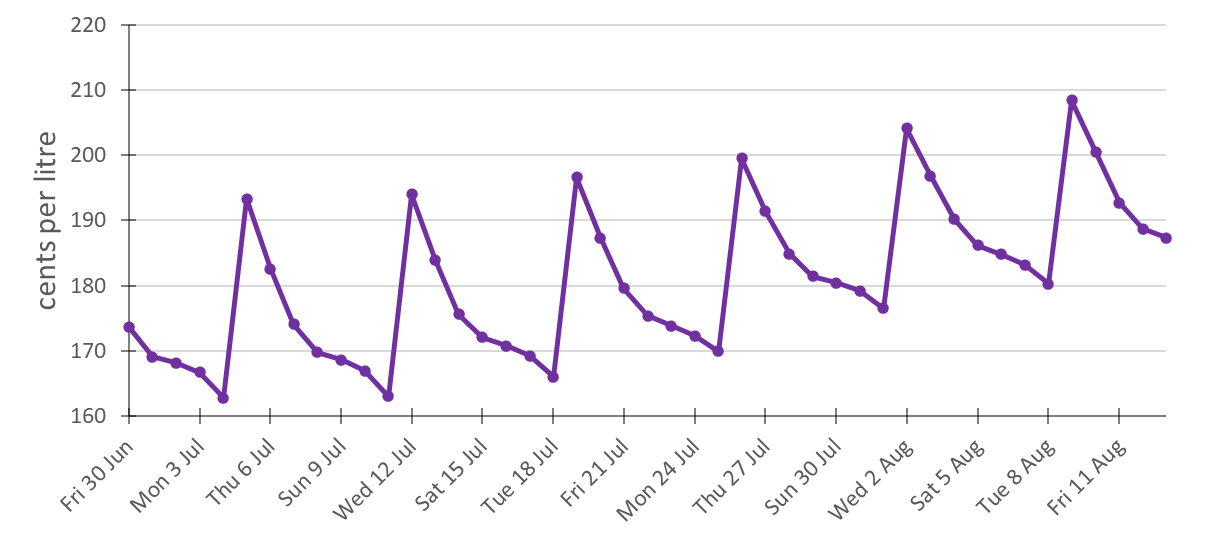If you are a driver in Australia, you may have noticed that petrol prices tend to fluctuate in a regular pattern. This is not a coincidence, but a result of deliberate pricing policies of petrol retailers. These policies create what are known as petrol price cycles, which are the consistent movement of prices up and down over a regular period.
In this blog post, we will explain what petrol price cycles are, how they work, how long they last, and how you can use them to save money on your fuel expences.

Sources: FUELtrac and Informed Sources.
What are petrol price cycles?
Petrol price cycles are the result of pricing policies and not from changes in the wholesale cost of fuel1. They are a movement in the retail price from a low point (or trough) to a high point (or peak) to the following low point. Petrol prices steadily decrease for a period followed by a sharper increase. This pattern is also known as a sawtooth pattern2.
Petrol price cycles occur in Australia’s major cities, such as Sydney, Melbourne, Brisbane, Adelaide and Perth. They do not occur in Canberra, Hobart and Darwin1.
Petrol price cycles are the result of competition among petrol retailers. Retailers try to attract customers by lowering their prices until they reach a point where they can no longer afford to do so. Then they raise their prices to recover their losses and make a profit. This cycle repeats itself over time.
How do petrol price cycles work?
Petrol price cycles vary in duration and magnitude depending on the city and the time of the year. The duration of each petrol price cycle varies from cycle to cycle and by location. The length of price cycles in Sydney, Melbourne and Brisbane was around 5 weeks in 2022, and in Adelaide it was just over 2 weeks. Perth currently has regular weekly price cycles3.
The magnitude of petrol price cycles is the difference between the peak and the trough prices. The magnitude of price cycles in Sydney, Melbourne and Brisbane was around 30 cents per litre in 2022, and in Adelaide it was around 20 cents per litre. Perth’s weekly price cycles have a smaller magnitude of around 10 cents per litre3.
The timing of petrol price cycles is not random, but influenced by factors such as demand, supply, competition, market conditions and consumer behaviour. For example, petrol prices tend to be higher on weekends, public holidays and during school holidays when demand is higher. Petrol prices also tend to be higher when oil prices are high or when the Australian dollar is weak.

Sources: FUELtrac and Informed Sources.
How long do fuel price cycles last?
There is no definitive answer to how long petrol price cycles last, as they are unpredictable and subject to change. However, historical data can provide some indication or suggestion of the cheapest and most expensive days to buy petrol in the future.
The Australian Competition and Consumer Commission (ACCC) monitors petrol price cycles in Australia’s major cities and provides buying tips for consumers as a guide3. The buying tips are updated on weekdays (at least Monday, Wednesday and Friday) around midday.
The ACCC also provides historical data on the past 5 price cycles for each city on its website3. You can use this data to see when the last peak and trough occurred, how long the cycle lasted, and how much the prices changed.
How can you use fuel price cycles to save money?
By understanding how fuel price cycles work and using the available information from the ACCC, you can plan your fuel purchases accordingly and save money on your fuel expenses.
Here are some tips on how to use petrol price cycles to your advantage:
- Buy petrol when prices are low or decreasing. Avoid buying petrol when prices are high or increasing.
- Use online tools or apps that compare petrol prices across different stations and locations. You can find the cheapest or nearest station that suits your needs.
- Shop around for the best deal. Don’t assume that all stations have the same prices or that your usual station has the best prices.
- Be flexible with your timing. If you can wait for a few days or weeks until prices drop, you can save more money than buying at the peak.
- Be aware of external factors that may affect petrol prices. Keep an eye on oil prices, exchange rates, demand and supply conditions, and other events that may influence petrol prices.
By following these tips, you can make informed decisions about when and where to buy petrol and save money on your fuel expenses.
References
1. accc.gov.au
2. accc.gov.au
3. accc.gov.au
4. abc.net.au


Leave a Reply